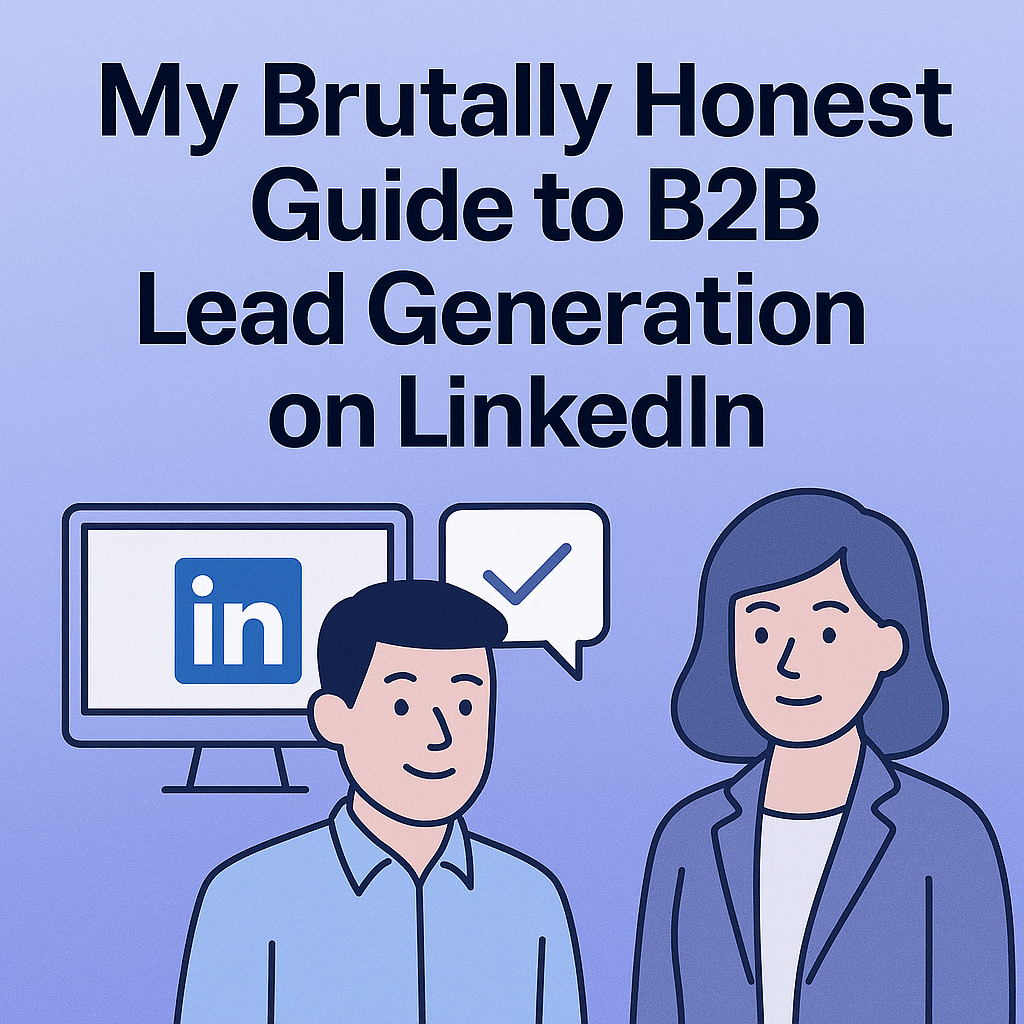My No-BS LinkedIn Lead Generation Strategy (That Actually Works)
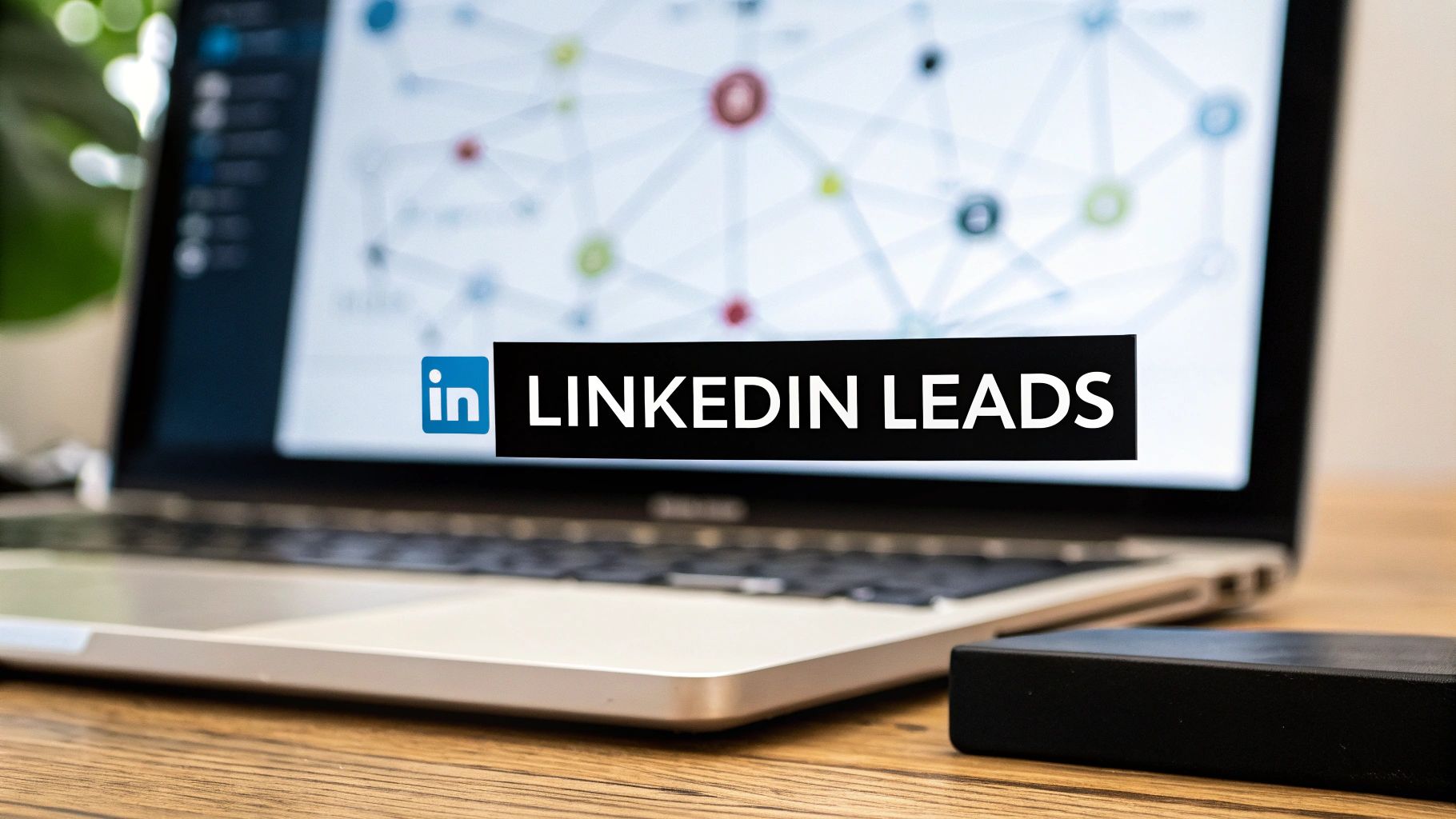
A solid LinkedIn lead generation strategy isn't about blasting out sales pitches and hoping something sticks. I learned that the hard way. It’s about building real, genuine relationships. This means creating a profile that pulls people, finding the exact right audience, and then engaging them with truly valuable content and personalized messages. Do that, and you'll attract high-quality leads like clockwork.
Why Your LinkedIn Strategy Is Failing You (And How to Fix It)
Let's be brutally honest for a second. You’re putting in the effort, connecting with people, posting content, maybe even dabbling in ads, but the pipeline of quality leads is dry. Sound familiar? It’s a frustrating spot to be in, and believe me, I’ve been there. My first real attempt at a big campaign was a complete disaster because I treated LinkedIn like it was my megaphone. I sent hundreds of generic DMs and got… nothing.
The tough pill to swallow is that most LinkedIn strategies fizzle out because they’re built on a shaky foundation. See if any of these common mistakes hit a little too close to home:
- Your profile is a resume, not a resource. It showcases your job title and what you've accomplished, but does it speak about your ideal client's actual problems? Probably not.
- Your outreach feels robotic and is all about you. You're sending out generic connection requests and then, boom, a sales pitch enters their inbox. That's a surefire way to get ignored and even blocked.
- You're broadcasting, not building a community. You post something and then vanish, completely ignoring the goldmine of opportunities waiting in the comments and your DMs.
I learned a massive lesson from that failed campaign: you have to shift your entire mindset from selling to helping. When you genuinely focus on providing value and solving problems for people, you attract the ones who want to work with you. The data backs this up completely.
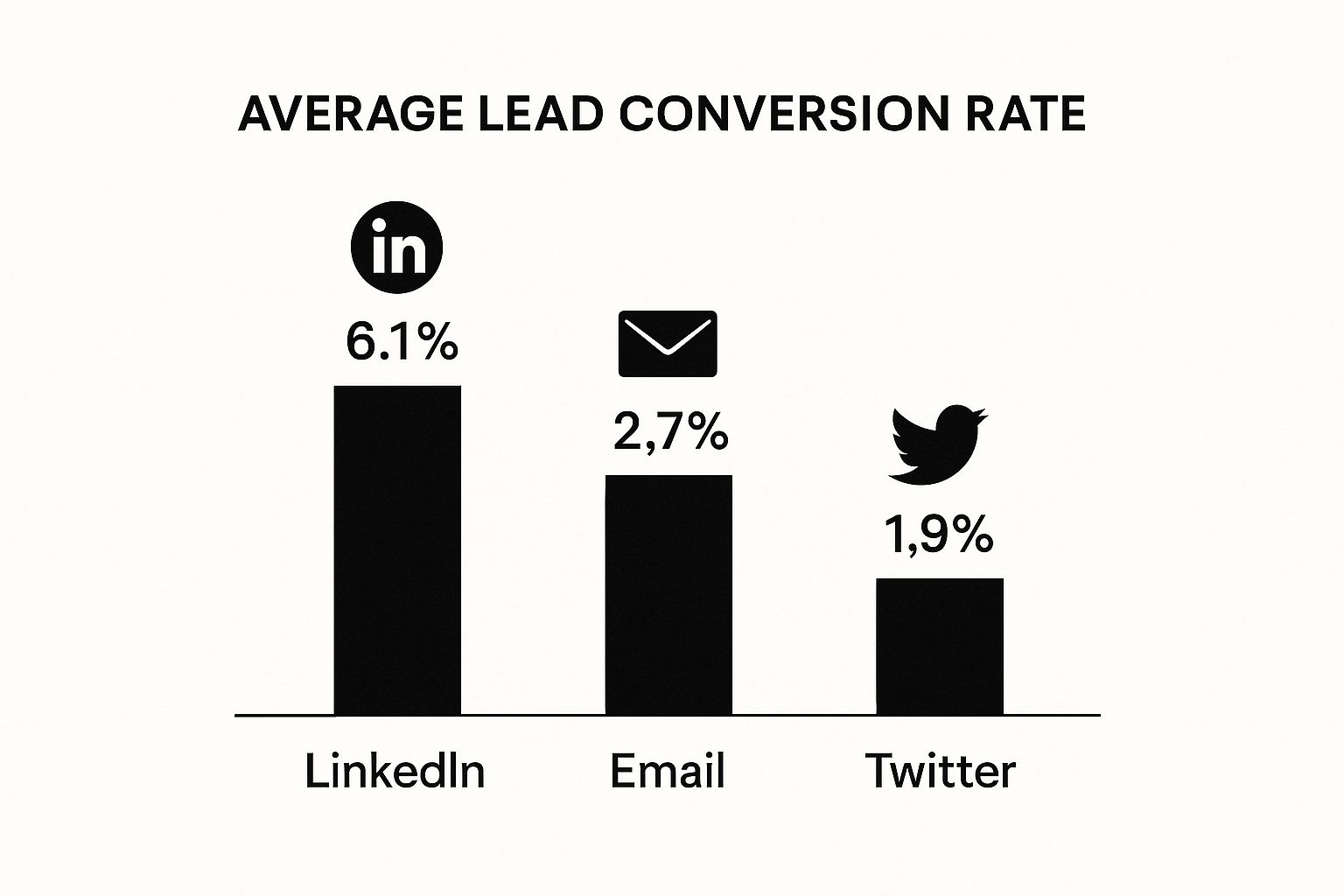
As you can see, LinkedIn crushes other channels in terms of lead conversion. It's a platform you have to get right.
Ditching What Doesn't Work
There's no denying that LinkedIn is a powerhouse in the B2B space. Nearly 89% of B2B marketers lean on it for lead generation, and a staggering 40% say it's their single most effective channel for sourcing high-quality leads. Even its native Lead Gen Forms can hit conversion rates as high as 13%, which makes the typical 2.35% landing page conversion rate look tiny. You can dig into more powerful LinkedIn stats if you're curious.
So, if the potential is there, what’s the problem? Too many people are still clinging to outdated tactics that don't work.
The single biggest mistake I see people make is focusing on quantity over quality. I used to think sending 100 generic connection requests a day was productive. It wasn't. It just annoyed 100 people. Sending just 5 highly personalized, thoughtful messages will deliver far better results. Your goal isn't just to add another connection; it's to start a meaningful conversation.
To nail this, you have to stop thinking like a bot and start acting like a human. Here's a quick look at the old way versus the new way of thinking.
Outdated Tactics vs Modern Strategy
This isn’t about just being busy on LinkedIn; it’s about being effective. Before we start building a winning strategy from the ground up, you first have to unlearn the bad habits holding you back. Ready to stop guessing and start building a lead gen engine that delivers?
Crafting a Magnetic and High-Converting Profile
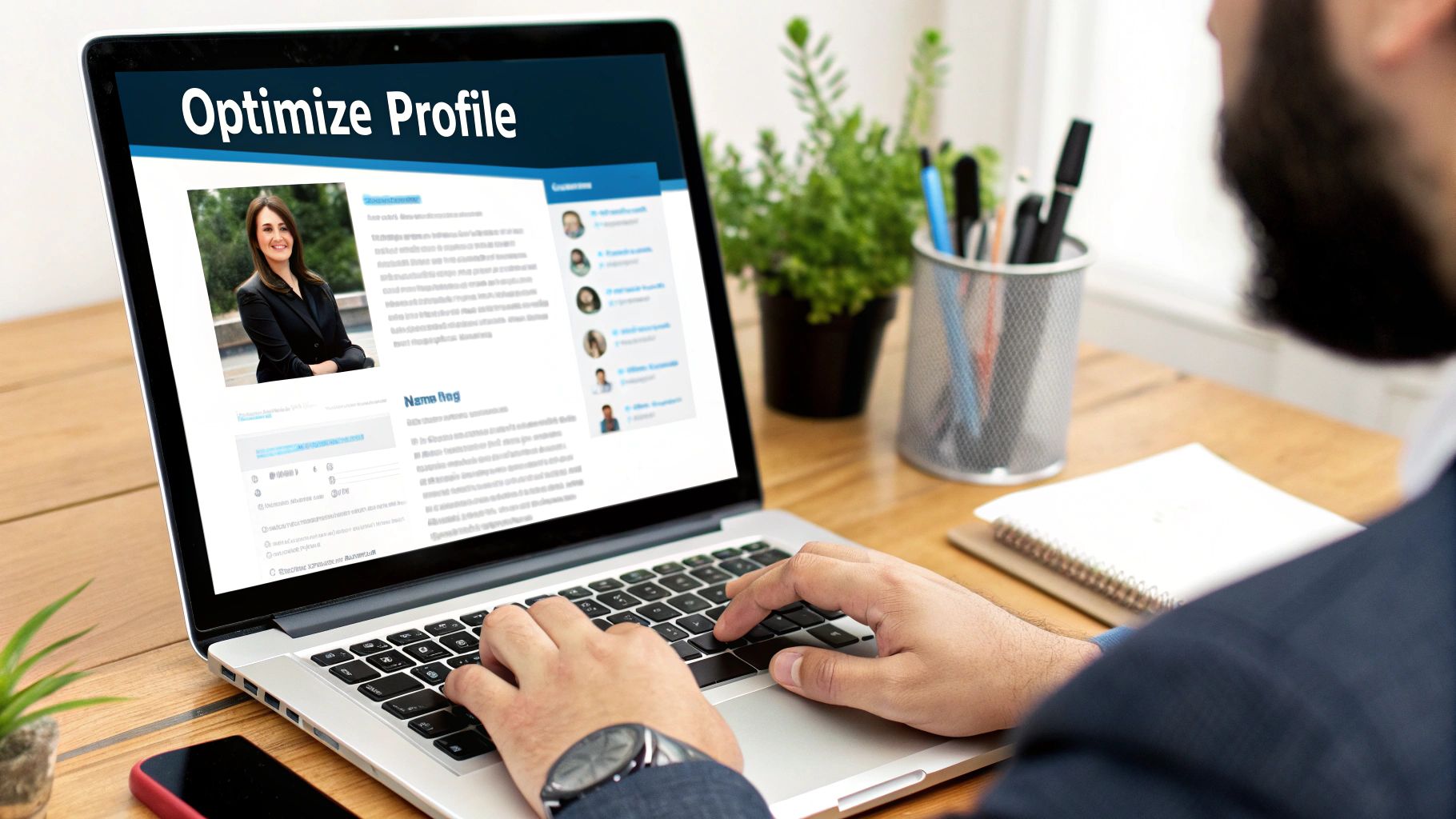
Let’s be honest for a second. Your LinkedIn profile is your digital salesperson, working around the clock. But is it selling, or is it just another online résumé collecting dust? Most profiles I come across are just a list of past jobs. Frankly, they're a snooze.
Nobody cares that you were "responsible for Q3 deliverables" back in 2018. What they do care about is what you can do for them, right now. It's time to shift your profile from a passive, backward-looking document into an active, lead-generating machine. The goal is simple: when your ideal prospect lands on your page, their gut reaction should be, "This person gets my problem. I need to talk to them."
Your Headline Is Your Hook
This is arguably the most critical piece of real estate on your entire profile. It follows you everywhere you go on LinkedIn, in connection requests, comments, and search results. The default for most people is just their job title, like "Sales Manager at XYZ Corp." Yawn.
Let's do better. Your headline shouldn't just state what you are; it needs to shout what you do for people. It should showcase the tangible result you deliver for your ideal client.
Before (The Snoozer):
"Account Executive at TechSolutions Inc."
After (The Head-Turner):
"I Help SaaS Founders Cut Customer Churn by 30% | B2B Growth Strategy | Scaling ARR"
See the difference? The second version is a mini-pitch. It immediately identifies the target audience (SaaS Founders), quantifies a specific outcome (cut churn by 30%), and is packed with keywords that attract the right kind of attention. This one small tweak is a massive upgrade for your entire LinkedIn lead generation strategy.
Action Point: Go to your profile right now and rewrite your headline. Use this formula: "I help [Your Ideal Client] achieve [Specific, Quantifiable Result]."
Tell a Story, Not a History Lesson
Your 'About' section is where the real connection happens. Please, I’m begging you, don't just list your skills and rehash your career history. That’s what the 'Experience' section is for. This space is your opportunity to tell a compelling story that resonates with your prospect's biggest challenges.
For years, I made this mistake myself. My 'About' section was a summary that was like an article written by a corporate robot. It generated zero interest. Now, I stick to a simple, effective framework:
- Hook: Open with a question or a bold statement that hits on your ideal client's primary frustration. Example: "Struggling to keep your best customers from walking out the door?"
- Problem: Prove you understand their world by addressing the specific issues they face each day.
- Solution: Briefly touch on how you solve that problem. This is where you introduce your unique value.
- Proof: Back it up with a hard number, a quick case study, or a client testimonial.
- Call to Action (CTA): End by telling them exactly what to do next. Want them to book a call? Have them visit your website? Connect? Be crystal clear. Example: "Ready to turn churn into retention? Send me a DM or book a free chat here: [Your Calendly Link]"
NEVER DO THIS: Your LinkedIn profile is no longer for recruiters (unless you're job hunting, of course). It's for your future customers. You have to stop writing for your old boss and start writing for your next client.
Showcase Your Wins in the Featured Section
Think of this as your trophy case! The 'Featured' section is a highly visual, clickable portfolio sitting right below your 'About' summary. Leaving this section blank is a huge missed opportunity. You can feature posts, articles, external links, and other media to show your expertise.
Here’s a checklist of what you should feature:
- A Powerful Case Study: Link to a PDF or a blog post that walks through how you helped a client achieve an impressive, specific result.
- Client Testimonials: A short video or a simple graphic with a glowing quote from a happy customer is pure social proof gold.
- A Value-Packed Post: Did one of your LinkedIn posts get great engagement? Feature it! This shows your expertise in action.
- A Link to Book a Call: Make it easy for an interested prospect to connect with you by linking directly to your Calendly or another scheduling tool.
By focusing on these three key areas: the headline, 'About' section, and 'Featured' section, you transform your profile from a static page into a dynamic engine that actively fuels your LinkedIn lead generation. It's time to stop just being on LinkedIn and start making LinkedIn work for you.
Finding Your Ideal Clients Without Wasting Hours

Alright, let's talk about the endless, soul-crushing scroll. We've all been there, spending hours tumbling down the LinkedIn rabbit hole, slinging connection requests like spaghetti at a wall, and just hoping a lead sticks. It was exhausting and, frankly, a terrible use of my time. The real power of LinkedIn for lead generation isn't just being there; it's mastering its powerful search.
The problem is, most people treat LinkedIn's search bar like it’s Google, barely scratching the surface of what it can do. Can you afford to burn hours on prospects who aren't a great fit? I know I couldn't.
That’s when I got serious about becoming a search ninja. It all starts when you move past the basic filters and embrace the absolute powerhouse that is LinkedIn Sales Navigator.
Beyond Basic Search With Sales Navigator
If you're truly committed to B2B sales, Sales Navigator isn't a "nice-to-have" but an essential part of your toolkit. Think of the free LinkedIn search as a flashlight in a cavern; Sales Navigator is like flipping on the stadium lights. It unlocks a whole suite of advanced filters that let you build hyper-targeted lead lists with surgical precision.
My biggest mistake early on was filtering by "Job Title" and "Industry." That mistake gave me a massive list of semi-relevant people who had no real reason to talk to me. The game completely changed when I started layering in intent signals.
These are the filters that show you who is active and far more likely to be receptive to your outreach. Here are my go-to signals:
- Changed jobs in the last 90 days: A New role often means a new budget and new problems to solve. These people are likely the most prepared to hear about new solutions.
- Posted on LinkedIn within the last 30 days: This is a dead giveaway that they're an active user, not a ghost profile. Engaging with their recent content is the perfect, non-creepy way to initiate a conversation.
- Follows your company: This is the lowest-hanging fruit you can find! They already know who you are, which gives you an immediate warm opening.
My Step-by-Step Playbook for a Killer Lead List
Ready to stop guessing? Here’s the exact process I run to build a list of high-intent prospects. Let’s imagine we’re hunting for VPs of Marketing in the US SaaS world who might need our services.
First, pop open Sales Navigator and lay down your foundation:
- Geography: "United States"
- Industry: "Software Development"
- Job Title: Use Boolean search for this. A good string would be: "VP of Marketing" OR "Vice President of Marketing" NOT "Assistant"
Next, layer on the magic, the intent filters. Under "Spotlights," I immediately apply these two:
4. Click on "Posted on LinkedIn in the last 30 days". This instantly weeds out the inactive accounts.
5. Add "Changed jobs in last 90 days". These are folks in a state of professional flux, making them prime targets.
Finally, and this is crucial, don't just run the search once. Click "Save search" at the top right. Give it a clear name you'll remember, such as "Active US SaaS Marketing VPs."
Why is saving the search so important? LinkedIn will now keep this list automatically updated for you. Every week, you'll get an alert with new professionals who fit your exact, high-intent criteria. You’ll have a fresh, warm pool of prospects just waiting for you.
Action Point: Set up and save your first high-intent search in Sales Navigator this week. Make it a goal to review the new leads for 15 minutes every Monday morning.
This targeted method ensures every connection request has a clear purpose. You’re no longer just another random person in their inbox; you're a relevant professional showing up at just the right moment. The potential here is massive. Between 2019 and 2025, LinkedIn's user base skyrocketed from 644 million to over 1.15 billion members. The right people are on there; you have to know how to find them.
For those just starting who aren't quite ready for a paid tool, you can still be effective. Find more in our guide on the top free LinkedIn lead generation tools to get going without a budget.
What to NEVER Do When Searching
- NEVER rely on just one filter. A title alone tells you nothing. Context is everything.
- NEVER save a static list. Always use the "Save Search" feature to keep your pipeline dynamic and fresh.
- NEVER ignore the "NOT" Boolean operator. Excluding titles like "Assistant," "Intern," or "Former" is a powerful way to clean up your results and save time.
This refined approach is the bedrock of a successful LinkedIn strategy. It eliminates the guesswork and puts you in control, making sure you’re only talking to the people who are most likely to become your next best customers.
Crafting Messages That Get Replies

This is where the rubber meets the road. It's the moment where most B2B sales pros torpedo their entire LinkedIn strategy. You can have a killer profile and a perfectly curated list of prospects, but if your first message is garbage, it was all a waste of time.
We’ve all seen them. That generic, zero-effort "I'd like to connect" request? Deleted. That immediate, copy-pasted sales pitch that hits my inbox the second I accept? You’re getting an instant "remove connection," and I'm probably blocking you for good measure. I’ve made these mistakes myself early on, and they are absolute conversion killers.
Let's do better. It’s time to stop sounding like a bot and start communicating like a human. The secret isn't some complex, mind-bending formula; it's about being personal, relevant, and genuinely valuable.
The Psychology of That First Message
Before you type a single word, get this straight: nobody on LinkedIn woke up this morning hoping a stranger would slide into their DMs with a sales pitch. Your only goal is to start a conversation, not to sell.
The best outreach feels less like a cold call and more like you’re tapping someone on the shoulder at a conference. How do you pull that off digitally? You find a real point of commonality.
- Did they recently publish a fascinating article on a topic you know inside and out?
- Did you notice that you attended the same university?
- Are they connected with a former colleague you trust and respect?
These are your ways in. Referencing a shared connection, a recent post, or a common interest makes your message feel thoughtful, not automated. It proves you spent more than three seconds glancing at their profile.
A Connection Request Blueprint That Works
That little text box in the connection request is prime real estate. Leaving it blank is a rookie move that screams "I'm just trying to boost my connection count."
Here’s a simple, field-tested template that consistently gets me an acceptance rate of over 70%.
My Go-To Connection Request:
"Hi [First Name], I saw your recent post on [Topic] and loved your take on [Specific Point]. I've been following the space closely myself. Would be great to connect and follow your work."
Why is this so effective?
- It’s Personal: It immediately calls out something specific they did.
- It’s Flattering: You're not just complimenting them; you're recognizing their expertise.
- It’s Low-Pressure: The ask is simple and non-threatening: just a connection.
This one small adjustment will immediately put you ahead of 90% of the other people filling up their inboxes.
What to Avoid at All Costs
I’ve learned these lessons the hard way, so you don’t have to. Steer clear of these messaging sins:
- NEVER pitch in the connection request. I can't stress this enough. It’s the digital equivalent of proposing on a first date. It’s desperate and weird.
- NEVER use vague compliments. "I love your work" is meaningless. "Your data on customer churn in your latest article was eye-opening" is specific and proves you paid attention.
- NEVER lie. Don't claim you loved a post you didn't read. People can smell fakes a mile away, and you'll destroy any chance of building trust.
- NEVER send a wall of text. Keep it short, scannable, and easy to reply to on a phone.
The moment a prospect accepts your connection, they've extended a small amount of trust. The absolute worst thing you can do is immediately violate that trust with a selfish, tone-deaf sales pitch. Give first. Always.
The Art of the Graceful Follow-Up: A Step-by-Step Tutorial
Okay, they accepted. Mission accomplished, right? Not yet. Now is the time to nurture, not pounce. You have to give before you can ever hope to ask. Here’s a simple, patient sequence you can adapt and follow over the next week or two.
- The "Thank You & Give" (Day 1): Send a quick message, a day after they connect. Don't just say "Thanks for connecting." Add value. Share a link to an insightful article, a helpful tool, or a relevant industry report related to the topic you connected over. Make it a no-strings-attached gift.
- Actionable Script: "Thanks for connecting, [Name]! Following up on your post about [Topic], I thought you might find this report on [Related Trend] interesting. No pitch, just thought it was a great read. Cheers!"
- The Public Engagement (Days 2-7): Don't just live in the DMs. Your next move should be public. Go like and, more importantly, leave a thoughtful comment on one of their posts. This is a brilliant, non-invasive way to stay in their mind.
- The Gentle Pivot (After a week or more): Now, and only now, have you earned the right to pivot the conversation. Lead with their world, not yours.
- Actionable Script: "Hey [Name], given your focus on [Topic], I was curious—have you ever run into challenges with [Problem Your Product Solves]?"
- Give #1 (Problem/Solution): A text-only post detailing a common mistake your audience makes and a simple tip to fix it.
- Give #2 (Insight/Story): A personal story about a failure you experienced and the lesson you learned. This is how you build a real human connection.
- Give #3 (Resource): A carousel post that acts as a mini-tutorial, teaching your audience how to do something specific.
- The Ask (Soft CTA): A poll asking your audience about their biggest challenge, with the comment saying, "DM me 'HELP' if you're struggling with X, and I'll share a free resource."
- Text-Only Posts: Perfect for storytelling and sharing quick, punchy insights. They are incredibly easy to consume and receive great engagement, especially when formatted with plenty of white space.
- Carousels (PDFs): Honestly, these are my secret weapon for lead generation. You can pack a ton of value into a 5-10 page "slide deck," establishing deep expertise almost instantly. Plus, they get shared a lot.
- Polls: The ultimate engagement magnet. They are low-effort tools that your audience engages with. And it also provides you with insights into their biggest pain points.
- Short Videos (1-3 mins): Nothing builds trust faster than seeing your face and hearing your voice. Use them to share quick tips or behind-the-scenes content. Keep it authentic, no need for a Hollywood production!
- First 10 Minutes: Engage with Your Network. Open your LinkedIn feed and start scrolling with purpose. Your goal is to leave 3-5 genuinely thoughtful comments on posts from your target prospects and key industry players. Go beyond "Great post!" and add a real insight or a question. This is how you stay visible and relevant.
- Next 15 Minutes: Send Targeted Connection Requests. Now, head over to your saved search in Sales Navigator. It’s time for outreach. Send 5-10 highly personalized connection requests. Remember the templates we covered? Reference something specific, a recent post, a shared connection, or their company's news. This is all about quality, not quantity.
- Final 5 Minutes: Manage Your Inbox. Check your messages and new connection acceptances. This is where you apply the "Thank You & Give" principle. Have a link to a helpful resource or a relevant article. Keep the conversation moving forward.
This approach is built on patience and respect. It builds genuine rapport and earns you the right to ask for their time and ears. Here is the complete Warm DM Playbook, which breaks down this entire process with more templates and advanced tactics.
Mastering the art of the message is about shifting your entire mindset from "What can I get?" to "What can I give?" Once you do that, you won't just be generating leads; you'll be building valuable professional relationships that pay dividends for years to come.
Creating Content That Converts Prospects Into Leads
If your optimized profile is your digital storefront, then your content is the town crier, shouting from the rooftops to pull in the right crowd. But what do you post? I used to get paralyzed by this question. I'd stare at a blank "Create a post" box, terrified of putting something out there that would get zero engagement.
The biggest mistake I made early on was chasing vanity metrics, such as likes and views from anyone and everyone. Sure, it felt good for my ego, but it did nothing for my sales pipeline. The game changed when I realized that a solid LinkedIn strategy isn't about going viral. It's about consistently creating content that solves my ideal client's problems and cements my authority in their minds.
This shift in focus is critical. You don't need me to tell you LinkedIn is a B2B powerhouse, but the numbers are staggering: it generates 277% more high-quality leads than Facebook. With over half of all B2B marketers giving LinkedIn the top spot for ROI, it's a no-brainer that a focused content strategy is the key to unlocking that potential. If you're a data nerd like me, you can dive deeper into these powerful LinkedIn marketing stats to see just how effective it can be.
My Simple Content Framework: Give, Give, Give, Ask
To avoid the "what do I post?" paralysis, I came up with a dead-simple framework that you can steal today: Give, Give, Give, Ask. For every four pieces of content you create, three should be purely about giving value. Only one should be a soft "ask."
This approach builds an incredible amount of trust and goodwill. By the time you do ask for something, such as a comment on a post, a DM, or a click to your website, your audience is primed and ready to engage because you’ve already given them so much for free.
Here’s what that looks like in practice:
The goal of your content is to make your prospects feel like they already know, like, and trust you before you ever slide into their DMs. It warms up your entire audience, making both inbound and outbound efforts dramatically more effective.
Content Formats That Work
So, what should these posts physically look like? Different formats serve different purposes, and you should mix them up to keep your feed fresh and engaging. Don't just stick to one.
Feeling stuck on post ideas? I get it. Creating consistently engaging content is a grind, which is why having a system is so important. If you need a creative boost, exploring a viral LinkedIn post generator can help you brainstorm compelling hooks and ideas to get the ball rolling.
Think of your content as an engine. When you build it right, it works for you 24/7, attracting inbound leads and warming up your outbound prospects so that when your name pops up in their inbox, they already know who you are and what you stand for.
Your 30-Minute Daily LinkedIn Lead Generation Domination Plan
Look, having a great plan is one thing, but if you don't put it into practice every single day, it's just a document collecting digital dust. The key to making LinkedIn work for you isn't about finding more hours in the day, but creating a focused habit that you can stick to.
I’ve seen too many reps get fired up about a new process, only to abandon it a week later when things get busy. This plan is designed to prevent that. It’s a simple, repeatable workflow that takes just 30 minutes and builds real momentum.
Your 30-Minute Daily Execution Plan
Block this time out on your calendar. Treat it like a client meeting. Non-negotiable. Here’s how you break it down:
That's your entire routine. It’s structured enough to keep you on track but quick enough that you won’t fall into the black hole of endless scrolling.
The One Thing You Must Never Do
I learned this the hard way, so please listen. NEVER chase vanity metrics like profile views or likes. In my early days, my mood would swing based on how many likes a post got. It was a complete waste of emotional energy and a total distraction. It's a trap.
Your north star metric, the only one that truly matters is how the meaningful conversations started. How many DMs turned into a real dialogue? How many of your comments sparked a genuine back-and-forth? That is the only activity that directly builds your sales pipeline.
Conclusion: Stop Selling, Start Helping
We've covered a ton of ground, from optimizing your profile into a lead magnet to finding the right people and starting conversations that don't feel slimy. If you take one thing away from this guide, let it be this: your success on LinkedIn hinges on a massive mindset shift from "What can I get?" to "How can I help?"
Stop blasting generic pitches and start building genuine relationships. Stop writing for recruiters and start writing for your next customer. Stop chasing vanity metrics and start chasing meaningful conversations.
This isn't just another fleeting social media trend; it's the new standard for modern B2B selling. The strategies I've shared are the exact ones I used to go from getting zero results to building a predictable pipeline of high-quality leads. It's not magic, it's a process. And it's a process you can start today. Your future clients are on LinkedIn right now, waiting for someone who truly understands their problems. Why shouldn't that person be you?
Frequently Asked Questions
How often should I post on LinkedIn for a better lead generation strategy?
Consistency beats intensity every single time. My advice? Aim to post 3-5 times per week. Posting every single day can lead to burnout and, frankly, lower-quality content. The key is to find a sustainable rhythm you can stick with for the long haul. This ensures your network sees you regularly, keeping you top-of-mind without overwhelming their feeds.
Should I focus on creating original content or sharing other people's posts?
The 80/20 rule is a great guideline here. 80% of your content should be original, created by you. This is what builds your unique authority and personal brand. The other 20% can be thoughtful shares of other people's content, but...and this is a big but, always add your unique insight or opinion in the post text. Never just hit "repost" without adding value. A great share adds context, such as "This is a great point by Jane, but I've found that in the SaaS space, you also need to consider X..."
What are the best times to post on LinkedIn?
While you'll see general "best practices" out there (typically mid-morning on Tuesdays, Wednesdays, and Thursdays), the absolute best time to post is when your specific audience is most active. Your data is your best friend here. Check your post analytics to see when you get the most engagement. You can experiment by posting at different times to see what works for your target demographic. The numbers don't lie.
What’s the deal with LinkedIn automation tools? Should I use them?
Let's be direct: tread very carefully here. While some tools can be helpful for research, I strongly advise against automating your connection requests and direct messages. I’ve seen too many accounts get slapped with restrictions, and LinkedIn is only getting stricter about this.
But more importantly, automation kills the entire point of this strategy. We're trying to build genuine, human connections. That generic, automated "Hi [Name], I see we work in the same industry..." message is an instant turn-off. Everyone can spot it a mile away, and it torpedoes any chance you had of building real rapport.
Your personal touch and genuine interest are your biggest assets on this platform. Don't automate them away for a few extra vanity metrics.
Is Sales Navigator worth the money?
Let me frame it this way: a free LinkedIn account is like trying to navigate a new city with a folded paper map. Can you get where you're going? But Sales Navigator is like having a GPS with live traffic updates. It’s a complete game-changer.
If you are serious about B2B sales, the investment pays for itself almost instantly. The advanced search filters alone are worth the price, letting you pinpoint ideal prospects with incredible precision. Add in features like saved lead lists and crucial intent signals ("changed jobs in the past 90 days"), and it becomes an indispensable part of your toolkit.
You can build a decent lead generation process with a free account, but you can develop a truly hyper-targeted and efficient one with Sales Navigator. The difference is night and day.
Ready to stop guessing which leads are warm and start getting a daily list of prospects signaling strong buying intent? GojiberryAI tracks real-time signals on LinkedIn and delivers enriched leads directly to your CRM. See how it works!
More High-Intent Leads = Your New Growth Engine.
Start Now and Get New High Intent Leads DeliveredStraight to Slack or Your Inbox.







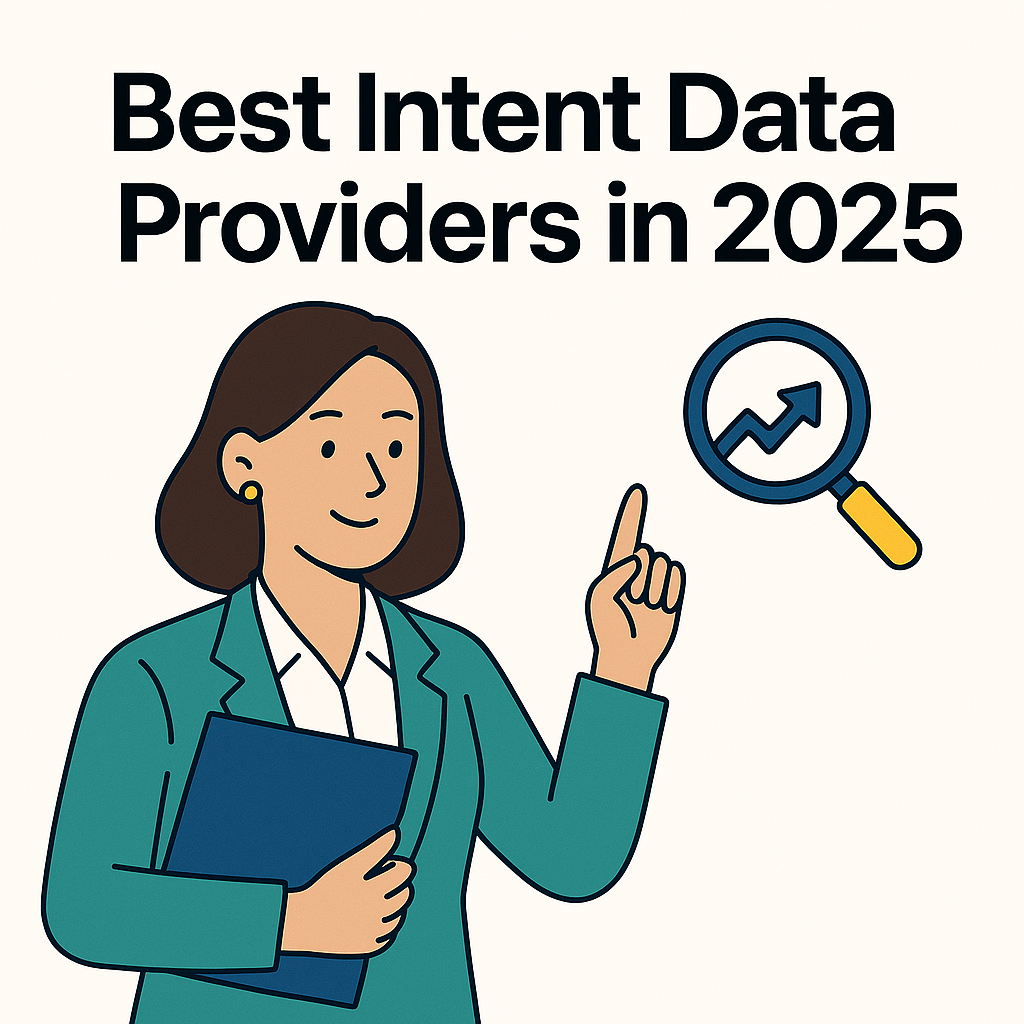

.png)
